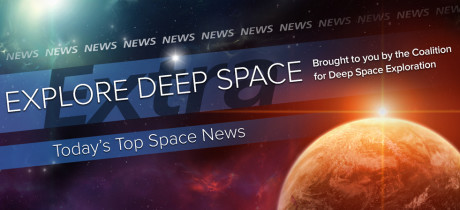In Today’s Deep Space Extra… A 2019 NASA funding measure that supports future human deep space exploration earns U.S. House Appropriations Committee backing. NASA Administrator Jim Bridenstine predicts continued development of the technically challenging Wide Field Infrared Space Telescope. Orbital ATK’s ninth NASA contracted cargo mission to the International Space Station (ISS) is set to launch early Sunday.
Policy and Budget
House Appropriations Committee approves FY2019 bill funding NASA and NOAA
Spacepolicyonline.com (5/17): The U.S. House Appropriations Committee marked up a $21.546 billion 2019 spending measure for NASA on Thursday. The legislation now moves on to the full House, collaborations with U.S. Senate appropriators and to the White House for the president’s signature. The bill’s top line is $1.6 billion more than the White House request for NASA spending in 2019 and $810 million more than the 2018 appropriation. The bill supports NASA efforts to complete development of the Orion capsule and Space Launch System (SLS) and Florida launch facilities to begin the assembly of the human tended Lunar Orbital Platform – Gateway and to return astronauts to the lunar surface.
House appropriations bill partially restores WFIRST funding
Space News (5/17): A House Commerce, Justice and Science 2019 appropriations measure marked up Thursday by the Appropriations Committee offers some hope for the future of NASA’s technically challenged Wide Field Infrared Space Telescope (WFIRST) project, part of a $21.6 billion spending bill approved by the U.S. House Appropriations Committee on Thursday. The White House called for cancellation of the mission after it eclipsed a $3.2 million development cost cap. The markup moves on the full U. S. House.
Human Space Exploration
Top NASA overseer says other nations need to ‘pony up’ for space station
Politico (5/18): Rep. Brian Babin, chairman of the House Space Subcommittee, says that having enough money for NASA to send American astronauts to Mars may depend on international partners renting out parts of the International Space Station (ISS) for their own research. The Trump administration in March recommended that NASA gradually transition some station requirements from government to private industry, with the shift being mostly completed by 2025. “I think our partners up there are going to have to pony up,” Rep. Brian Babin (R-Texas) said. “They will have to lease out several floors on that big building flying around up there in space to help pay the bills and continue that research so we can be free to move onto human space flight.”
Contamination found in SLS engine tubing
Space News (5/17): A possible contamination issue in the core stage of NASA’s Space Launch System (SLS) rocket under development at the Michoud Assembly Facility in New Orleans was disclosed Thursday during a meeting of the agency’s Aerospace Safety Advisory Panel in Washington. The paraffin contamination in tubing within the SLS core stage was supposed to be removed by the vendor. It was unclear whether the issue might contribute to delays in planned test flights of the SLS and Orion.
Space Science
Bridenstine optimistic WFIRST will avoid cancellation
Space News (5/17): NASA Administrator Jim Bridenstine addressed a “town hall” at the agency’s Washington headquarters on Thursday. He forecast a “90 percent” chance that the technically challenging WFIRST space observatory will survive proposed cancellation. As a companion to the James Webb Space Telescope, WFIRST would launch in the 2020s to study dark energy and extra solar planets.
NASA’s Atomic fridge will make the ISS the coldest known place in the universe
Coalition Member in the News – Orbital ATK
Motherboard (5/17): The Cold Atom Lab, developed by NASA’s Jet Propulsion Laboratory (JPL), is among a science cargo set for launch on Sunday as part of Orbital ATK’s ninth NASA contracted resupply mission to the International Space Station. The experiment is designed to provide physicists with new insight into quantum physics at the lowest possible temperatures. Liftoff is set for early Sunday from NASA’s Wallops Island Flight Facility on Virginia’s Eastern Shore.
Small packages to test big space technology advances
Coalition Member in the News – Orbital ATK
NASA/Jet Propulsion Laboratory (5/17): Three CubeSats that are among the near 7,400 pound cargo slated for launch to the International Space Station early Sunday were developed to demonstrate new Earth observation technologies, including light weight radar instrumentation. The NASA contracted Orbital ATK resupply mission is scheduled to launch from the Wallops Island Flight Facility near Washington D.C. at 5:04 a.m., EDT.
What’s next for exoplanet searches? A talk with astrophysicist Sara Seager
Space.com (5/17): MIT astrophysicist Sara Seager is optimistic that NASA’s recently launched Transiting Exoplanet Survey Satellite and the forthcoming launch of the James Webb Space Telescope (JWST) will lead to discoveries of Earth like extrasolar planets that can be assessed for signs of biological activity.
Other News
Former astronaut and NASA chief Charles Bolden donates personal collection
Collectspace.com (5/17): Charles Bolden, the first African American to lead NASA, has donated his papers, mementos and artifacts from his career as a U.S. Marine corps aviator, NASA astronaut and space agency executive to the University of South Carolina. As an astronaut, the Columbia, S.C. native launched four times, piloting the 1990 shuttle mission that launched the Hubble Space Telescope and later helping to unite the U. S. and former Soviet Union in space after the Cold War for the assembly of the International Space Station (ISS). Bolden served as NASA’s administrator from 2009 to 2017.

